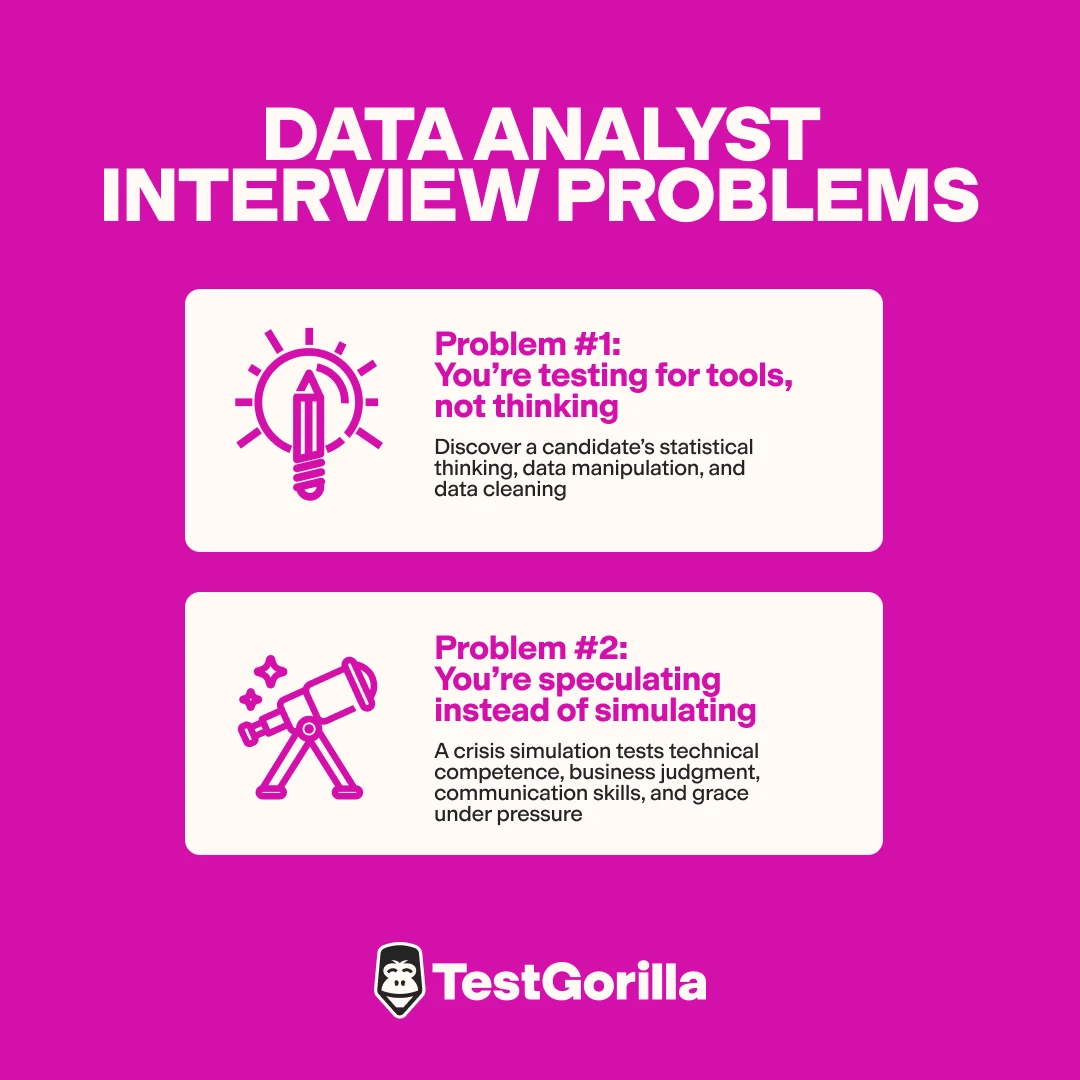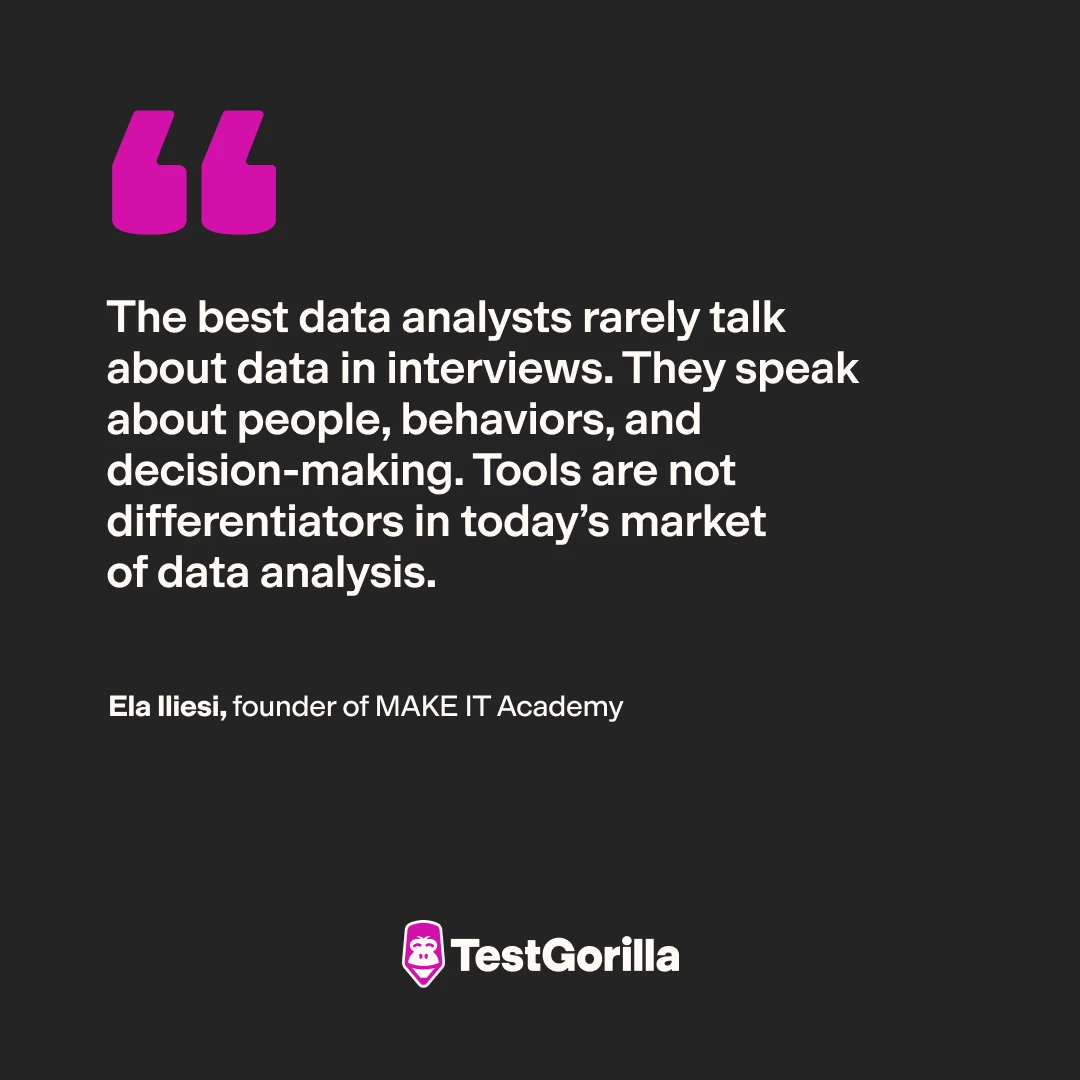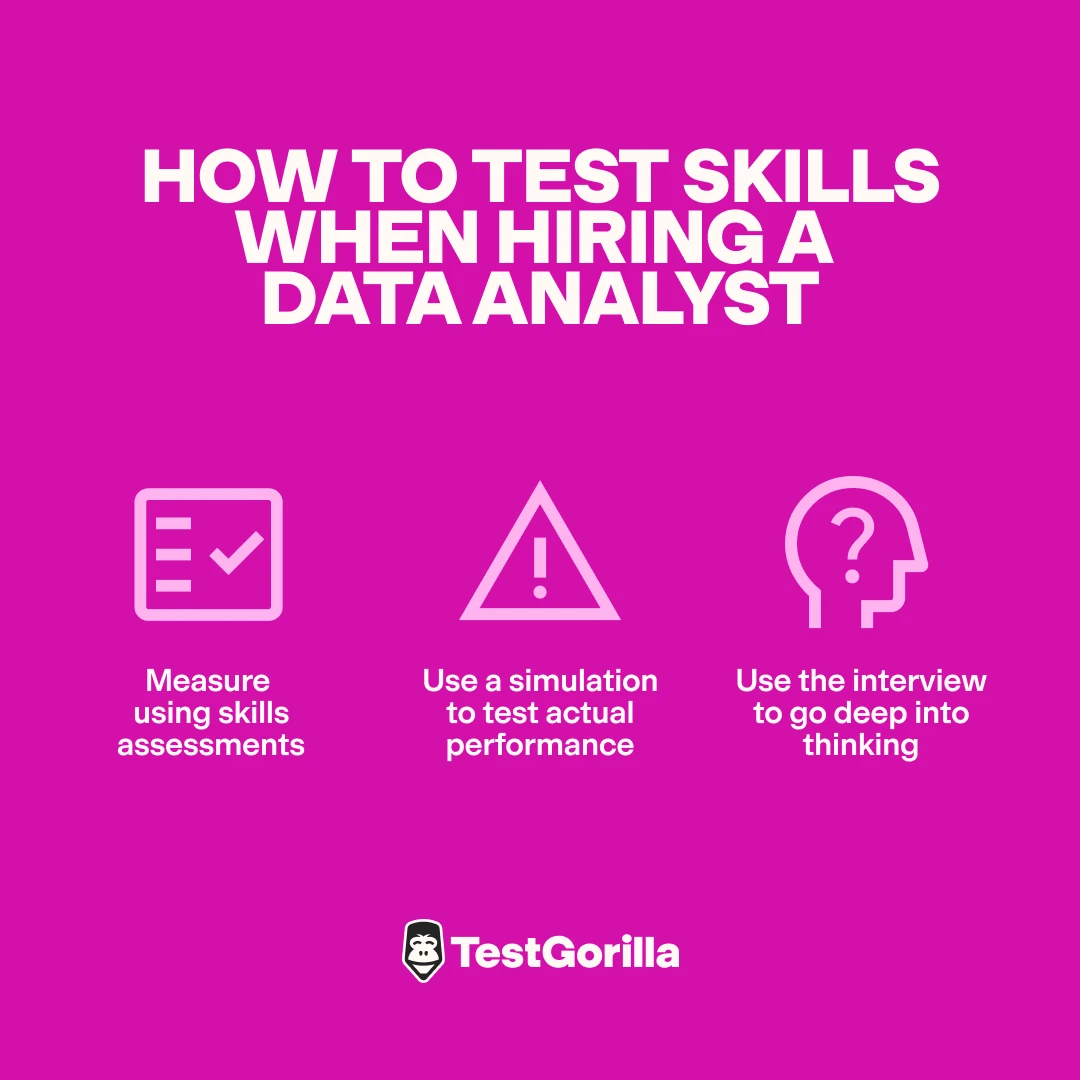Your data analysis interview questions are broken – here’s how to fix them
Let’s be blunt: Most data analyst interviews in the industry today are a waste of time.
Interviewers ask a dozen questions about SQL syntax, Power BI features, and VLOOKUPs, and they get a dozen perfectly rehearsed answers. They walk away knowing someone can define a left join – but not whether that person can think critically, solve ambiguous problems, or drive a decision that matters.
To fix that, you need to shift the focus. That means asking better questions – and using early signals that highlight how candidates work.
Tests like our Data Storytelling test and Exploratory Data Analysis test can help, but the bigger change is philosophical: start hiring for how people think, not just what they know.
Table of contents
Problem #1: You’re testing for tools, not thinking
When looking for candidates with data analysis skills, most hiring managers confuse tool proficiency with analytical capability.
But knowing how to write a window function is procedural knowledge: the ability to follow instructions. What you actually need to identify is conceptual knowledge: the deep, flexible understanding of principles that enables someone to solve a problem they’ve never encountered before.
As Ela Iliesi, founder of MAKE IT Academy, who has interviewed over 200 professionals, tells TestGorilla:
“The best data analysts rarely talk about data in interviews. They speak about people, behaviors, and decision-making. Tools are not differentiators in today’s market of data analysis. What sets someone apart is their ability to uncover unexpected correlations and ask the right questions. Like discovering... whodunnit.”
One of the best candidates Iliesi ever met didn’t tell a story about modeling or dashboards when asked about their most valuable analysis. The candidate simply replied that they had “discovered that the product abandonment rate was caused because in Chrome, the ‘Free shipping’ label was getting cut off on mobile.”
That’s it. No talk of big data stacks – just a sharp observation that solved a real business problem. In the end, that’s the type of data analyst you want.
Advanced data analysis interview questions that reveal judgment
When you’re trying to uncover conceptual knowledge, technical questions alone won’t get you there. You need to understand how candidates think: how they frame problems, weigh trade-offs, and make decisions with incomplete information. That requires a different kind of question.
Your interview questions should work as conversation starters on statistical thinking, data manipulation, and data cleaning – the data analyst skills that matter most.
Here’s what to ask and what to look for in candidates’ answers:
1. Tell me about the most complex analysis you’ve ever done – and start with the business question.
What to look for: They should be able to articulate the business problem in plain English. What were they trying to do? Where did they hit dead ends? How did they handle data cleaning and hypothesis testing to find the answer? The final result should be a clear story that led to someone making a different decision.
Red flags: They launch into a monologue about “end-to-end pipelines” and the tech they used. If they can’t explain the business impact of their work, there probably wasn't one!
2. Say you’re about to receive a messy dataset. What are the first three questions you ask before you write a single line of code?
What to look for: A great analyst’s first questions are about context, not code. They should be asking questions like, “Who will use this analysis? What decision will it drive? What does success look like?” They’ll also ask about how the data was collected, sniffing for potential bias. They're thinking about the integrity of the data before they even consider data manipulation.
Red flags: Questions about formats or environments (“What format is it in?” or “Which version of Python are you running?”). These suggest a technician mindset rather than a strategic one.
3. When has your analysis completely contradicted a client’s opinion or a long-held company belief? What happened?
What to look for: You want someone who follows the data, even when it leads to an uncomfortable place. Listen for the story of how they navigated the social dynamics of delivering bad news. Did they build a case? Did they persuade people? Or did they just email a chart and hope for the best?
Red flags: They seem to have only done analyses that confirmed what everyone already believed. This suggests they either don’t dig deep or they’re afraid to rock the boat. You don’t want either.
4. Explain statistical significance to me like I'm the head of sales.
What to look for: Can they eliminate technical jargon? Can they translate an abstract concept into business language? A great answer uses a simple, relevant analogy – something like, “Imagine you're deciding whether to roll out a new sales script to your entire team. Statistical significance tells us whether the 15% increase we saw in our test was real improvement, or just a hot streak. It's our way of knowing if we can confidently train everyone on the new script or if we need more data first.” This is data storytelling in its purest form.
Red flags: A textbook definition. If they start talking about “p-values” and the “null hypothesis” without connecting it to a business outcome, they can't bridge the gap between data and decisions.
5. Walk me through how you'd approach a dataset where 40% of the values are missing. What's your thought process?
What to look for: This tests their data cleaning instincts and statistical thinking. Strong candidates will ask about why data is missing first. Is it random? Systematic? They should discuss various imputation methods and their trade-offs, but more importantly, they should recognize that how this needs to be handled depends entirely on the business context and the analysis goals.
Red flags: They immediately jump to a single solution (“just drop the rows” or "impute with the mean") without understanding the context. This shows mechanical thinking rather than principled decision-making.
Problem #2: You’re speculating instead of simulating
The second fatal flaw in data analyst interviews is that they typically bear no resemblance to reality. Asking someone to solve a theoretical puzzle or define a statistical term doesn’t tell you how they’ll perform when the data is messy, the business context is unclear, and decisions need to be made under pressure.
And in many cases, traditional interviews don’t just fail to measure capability – they actively undermine it. Research by North Carolina State University found that programmer performance dropped by more than half when being observed by an interviewer. In other words, traditional interviews designed to reveal skill often do the opposite.
There’s a better alternative: tasks that simulate the real responsibilities outlined in your data analyst job description.
Nikodem Gabler, Marketing Lead at DoubleData, has turned this into an art form:
“We don't do normal interviews. We throw candidates into a crisis simulation. It's a 120-minute pressure cooker that shows us how they really handle a disaster. It’s one thing to solve a puzzle on a whiteboard; it's another to fix a system that's actively on fire.”
This simulation tests everything at once: technical competence, business judgment, communication skills, and grace under pressure. It uncovers how candidates handle data manipulation tasks, whether they can spot patterns through statistical analysis, and most importantly, whether they can create clear data visualization to explain complex problems.
Interview questions to use after a simulation
Once a candidate has completed the task, ask them about how they worked. These questions are designed to reveal process, priorities, and decision-making under pressure:
1. Okay, walk me through your first 20 minutes. What did you look at, and why?
What to look for: A methodical approach. Gabler says the amateurs jump right into the code. The pros spend their time doing exploratory data analysis. They run basic stats. They look for weird patterns. They form a quick theory and then try to prove it right or wrong.
Red flags: They can't explain their starting point. They just started randomly changing things, hoping to get lucky.
2. You found X bugs. How did you decide which one was the most important?
What to look for: The right answer has nothing to do with which bug was the most technically interesting, but which was hurting the client the most. This shows they can connect code to cash.
Red flags: They prioritize the bug that was hardest to find, showing they're more interested in the technical challenge than the business outcome.
3. Where did you get stuck? And how did you get unstuck?
What to look for: Honesty and resourcefulness. Every real project has a wall. A great analyst admits when they hit it and can talk about how they solved it. Did they re-frame the problem? Did they use an outside resource?
Red flags: “I never got stuck.” That’s either a mistruth or a sign they didn't tackle a hard enough problem.
4. (Now, role-play as the panicked client.) I don't get it. What's the actual risk here? Explain it to me in terms of my money or my customers.
What to look for: This is the ultimate test of data visualization skills. Can they drop the jargon and deliver a clear, persuasive message under pressure? "If we don’t fix this, we risk showing the wrong prices to 10% of our customers. That will damage their trust and could cost thousands in sales.”
Red flags: They retreat into technical explanations. They can't make the leap from a code flaw to a business catastrophe.
5. If you had to present these findings to our executive team in 10 minutes, what would your three main slides be?
What to look for: This tests everything at once: technical competence in statistical methods, data visualization, and strategic communication. They should focus on business impact first, then the solution, then the implementation plan. The best candidates will ask about the audience's background and concerns before structuring their response.
Red flags: They want to show every step of their analysis. They can't distinguish between what’s interesting to them and what’s important to the business.
The best insights on HR and recruitment, delivered to your inbox.
Biweekly updates. No spam. Unsubscribe any time.
Improving interviews is only part of the solution
Even the best interviews won’t get you closer to hiring a strong data analyst if the rest of your process is misaligned. You need a structured, end-to-end approach that measures real ability at every stage.
That’s where skills-based hiring comes in. And the data backs it up. According to our 2025 State of Skills-Based Hiring report:
76% of employers now use skills tests to measure and validate candidate abilities
Two-thirds say that using skills tests has reduced their number of mis-hires
Companies using skills tests before screening resumes are significantly more likely to make quality hires (96% vs. 87%)
Here’s how to put a skills-first process in place for your data analyst candidates:
1. Start with skills assessments
Before you even look at resumes, you’ll want an objective measure of each candidate’s core competencies. The best way to do this is through talent assessments, such as the ones TestGorilla can help you create.
Two tests in particular are crucial here – one that enables you to assess data exploration and another that helps you measure data storytelling skills. TestGorilla has tests for exactly these purposes:
Exploratory Data Analysis test: This 10-minute test evaluates candidates across three critical areas: feature engineering, data visualization, and statistical analysis. It measures their ability to extract key information from datasets, spot patterns, and convert business problems into data science solutions.
Data Storytelling test: This test evaluates four key competencies: data analysis, data visualization and presentation, storytelling and communication, and business understanding. It identifies candidates who can bridge the gap between raw data and actionable business outcomes.
Both tests save time, reduce the risk of bias, and enable you to filter out candidates who aren’t qualified. That way, you can offer interviews to only those with real potential.
2. Replace hypotheticals with a task
Design a short, realistic task that mirrors the challenges of the role. Use the insights from Gabler’s simulation as a model: Give candidates a messy dataset and a clear business problem, and see what they do. This becomes a preview of their actual performance.
3. Use the interview to go deep into thinking
Let the task drive the interview. Use it to explore the candidate’s thinking – how they approached the data, made trade-offs, and communicated their insights. Turn the conversation into a deep dive on judgment, process, and how they turn raw data into business value.
Make your next great hire with TestGorilla
The analysts who move the needle aren't those who can recite SQL commands on demand. They’re the analysts who can turn chaos into clarity and make executives care about what the numbers really say.
Building a team like that starts with skills-based assessments, such as TestGorilla’s Exploratory Data Analysis test and Data Storytelling test. Then, go deeper with interviews and simulations that evaluate how candidates navigate ambiguity, prioritize for business value, and communicate complex insights.
Want to see how TestGorilla can transform your hiring process? Sign up for a free account or book a free 30-minute demo today.
You've scrolled this far
Why not try TestGorilla for free, and see what happens when you put skills first.





















